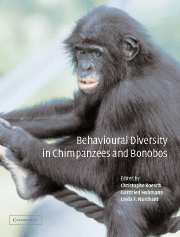Book contents
- Frontmatter
- Contents
- List of contributors
- Preface
- Behavioural Diversity in Pan
- PART I BEHAVIOURAL FLEXIBILITY
- INTRODUCTION
- 1 Multivariate and phylogenetic approaches to understanding chimpanzee and bonobo behavioral diversity
- 2 Chimpanzees in the dry habitats of Assirik, Senegal and Semliki Wildlife Reserve, Uganda
- 3 Behavioural adaptations to water scarcity in Tongo chimpanzees
- 4 Bonobos of the Lukuru Wildlife Research Project
- 5 Grooming-hand-clasp in Mahale M Group chimpanzees: implications for culture in social behaviours
- PART II SOCIAL RELATIONS
- PART III FEMALE STRATEGIES
- PART IV HUNTING AND FOOD SHARING
- PART V GENETIC DIVERSITY
- Index
2 - Chimpanzees in the dry habitats of Assirik, Senegal and Semliki Wildlife Reserve, Uganda
Published online by Cambridge University Press: 08 February 2010
- Frontmatter
- Contents
- List of contributors
- Preface
- Behavioural Diversity in Pan
- PART I BEHAVIOURAL FLEXIBILITY
- INTRODUCTION
- 1 Multivariate and phylogenetic approaches to understanding chimpanzee and bonobo behavioral diversity
- 2 Chimpanzees in the dry habitats of Assirik, Senegal and Semliki Wildlife Reserve, Uganda
- 3 Behavioural adaptations to water scarcity in Tongo chimpanzees
- 4 Bonobos of the Lukuru Wildlife Research Project
- 5 Grooming-hand-clasp in Mahale M Group chimpanzees: implications for culture in social behaviours
- PART II SOCIAL RELATIONS
- PART III FEMALE STRATEGIES
- PART IV HUNTING AND FOOD SHARING
- PART V GENETIC DIVERSITY
- Index
Summary
INTRODUCTION
Scenarios of ape–human divergence have often represented hominins as savanna-adapted (e.g. Dart 1959; Robinson 1972; Coppens 1988; Wheeler 1992), whereas the chimpanzee (Pan troglodytes) has been represented as rainforest-adapted. This dichotomy has eroded from both sides of the divide. Kano (1972) and McGrew et al. (1981) noted that the longest-studied chimpanzees, those at Gombe and Mahale, live in a grassland–woodland–forest mosaic, not tropical forest, and that other populations range into even drier, more open habitats (see the ‘savanna ape model’ in Moore 1996). The habitats of the earliest hominins were at least partly forested (Bonnefille 1984; WoldeGabriel et al. 1994, 2001). A less severely drawn contrast between ape and hominin habitats now seems a better fit with the evidence: Chimpanzee habitats range from closed-canopy rainforest to savanna, whereas early hominins likely occupied somewhat drier habitats, ranging from forest to woodland to savanna. This overlap means that primatologists can study the behavior of chimpanzees living in habitats nearly identical to those in which Mio-Pliocene hominins lived.
Study of chimpanzee diet, habitat use, ranging, and positional behavior in peripheral habitats will help establish whether water availability, food availability, food dispersion, vegetative cover, or climate limits the pan-African chimpanzee distribution. Better understanding of the factors that limit chimpanzees may help to identify niche differences between Mio-Pliocene apes and hominins.
Study of chimpanzees at the edges of the species' range may also have conservation implications. Documentation of the minimum requisites of the species is valuable for rehabilitation, relocation, and green corridor projects.
- Type
- Chapter
- Information
- Behavioural Diversity in Chimpanzees and Bonobos , pp. 35 - 51Publisher: Cambridge University PressPrint publication year: 2002
- 78
- Cited by

